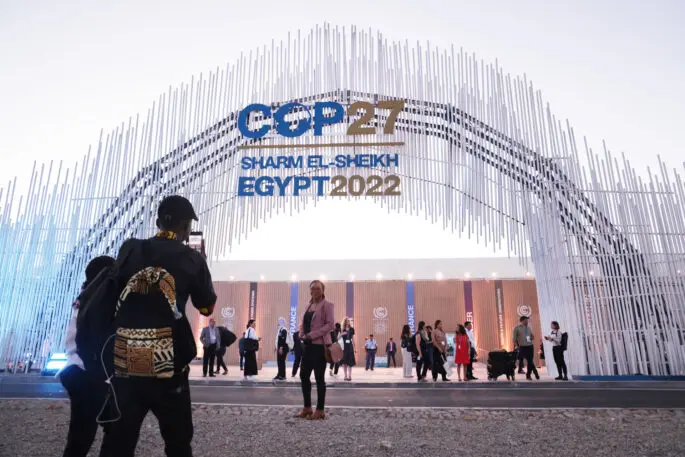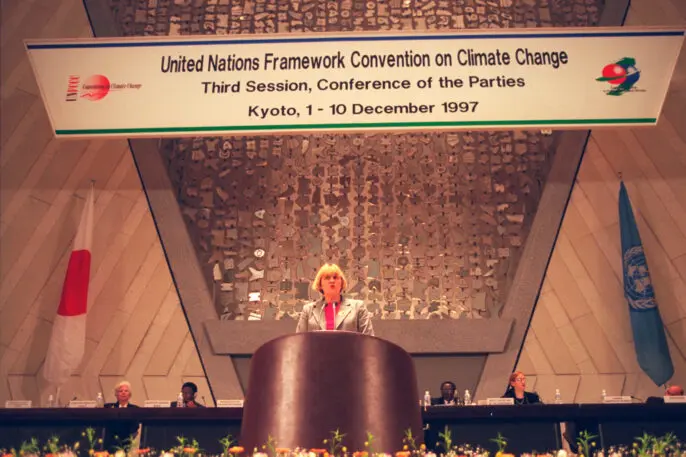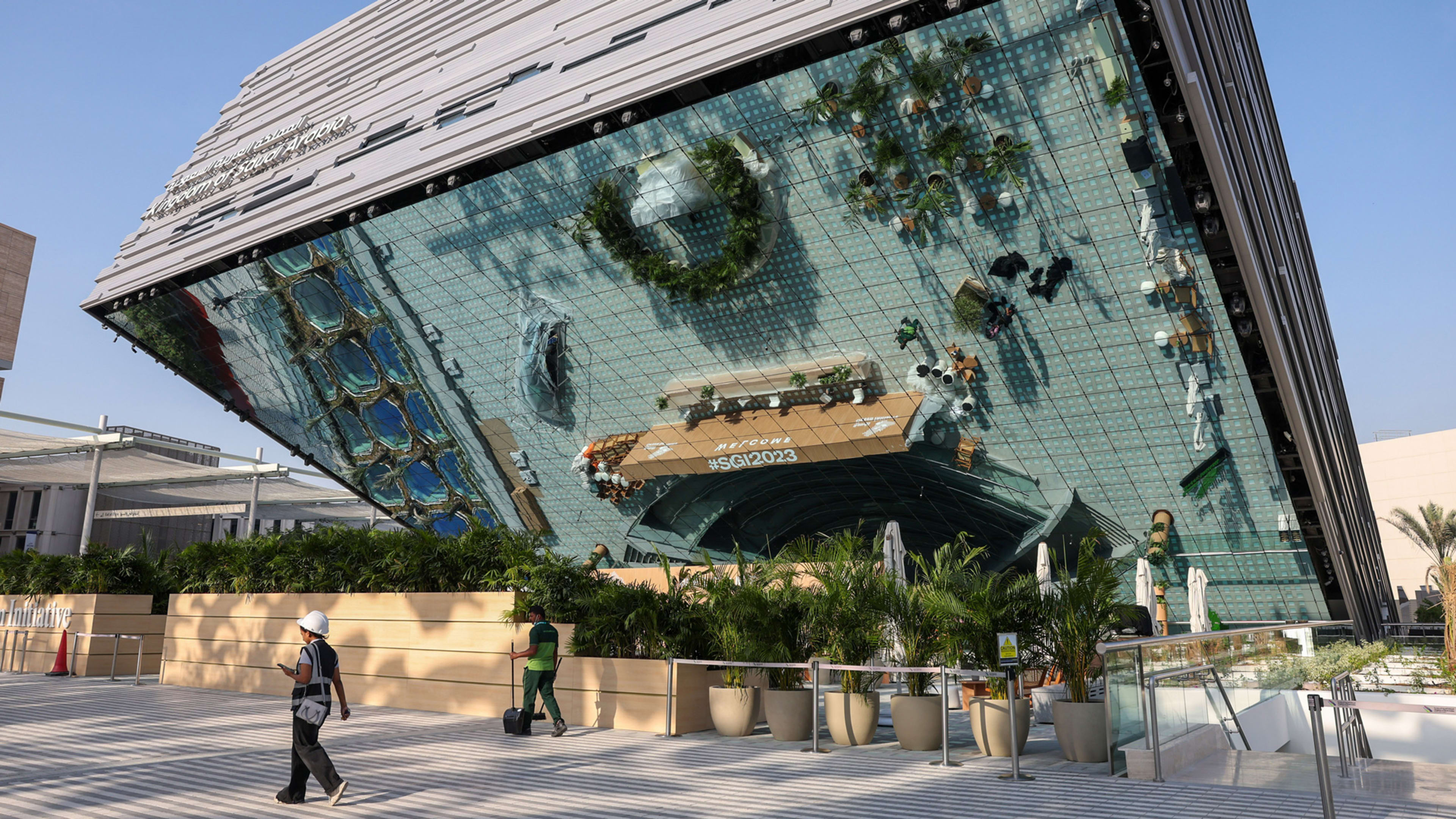When the United Nations held its first annual climate conference in 1995 in Berlin, Michael Jordan was still in the NBA, Google didn’t exist yet, and cellphones were rare. Times have changed. But 28 years—and 28 conferences later—we’re still not moving quickly enough to deal with climate change.
This week, tens of thousands of people will attend the 28th “COP,” or Conference of Parties, in Dubai. You might be wondering how much these summits actually accomplish. Here’s a short guide to the process.

Why do we have COPs?
The first global climate conference happened even earlier, in 1979, followed by another meeting in 1990 that set an agenda for negotiating a global climate treaty. In 1992, the UN General Assembly created the UN Framework Convention on Climate Change, an agreement to fight “dangerous human interference with the climate system.” In 1994, when 50 countries ratified the treaty, it went into effect, with the idea that countries would build on it to take action. Nearly every country in the world is now party to the agreement. One of the requirements of the UNFCCC is that the parties meet each year. At the meetings, countries assess progress in climate action (or lack of it) and negotiate next steps, including how to reduce emissions. Along with closed-door negotiations, summits also include side events ranging from talks on energy to exhibits about the future of food.
Who attends?
World leaders and other delegates attend official negotiations—though notably, in the hottest year in recorded history, President Biden isn’t planning to attend. (Other U.S. officials will.) Nonprofits and activists, including indigenous leaders, attend side events. Businesses are also heavily represented, especially oil companies: More than 7,200 fossil fuel company reps have attended previous talks, and that number is likely much larger.

What role do oil companies play at the meetings?
From the beginning, fossil fuel companies have pressured governments to move slowly on climate change and have worked to obscure the fact that fossil fuels are the biggest cause of the problem. Before the second COP, in 1996, the American Petroleum Institute, the oil and gas trade group, hired economists to calculate a biased estimate of the economic costs of a new climate treaty, and then sent lobbyists to the conference to convince governments not to act. The pressure has continued ever since.
Some governments have even included fossil fuel companies in their official delegations. Norway, for example, has two oil companies in its delegation for COP28. This year’s summit is being hosted in the United Arab Emirates, and the president of the event is also the head of the state oil company. Reportedly, he planned to use the event to discuss oil and gas deals with multiple countries.
“Last year’s COP was basically a trade fair for the oil industry,” says Bobby Banerjee, a professor of management who focuses on sustainability at the business school at City, University of London. “You had more people from the oil and gas companies than you had delegates.” At the 2022 conference, delegates drafted an agreement with strong language about phasing out fossil fuels, but “within 24 hours, the language was softened,” Banerjee says. “The word was that the oil and gas lobby took stronger sections and basically twisted the IPCC’s arm to make sure that the statement was watered down.”
Have we made any progress?
There has been progress, though not nearly enough. At the third COP, in Kyoto in 1997, countries negotiated a treaty that required developed nations to cut emissions. But the U.S. Congress didn’t ratify the deal, after pressure and more misleading statistics from oil lobbyists. The biggest step forward happened in Paris in 2015, when countries agreed to work to limit global warming to “well below” 2 degrees Celsius and aim for no more than 1.5 degrees of warming.

The agreement isn’t legally binding, unlike the Kyoto Protocol. But it has made a difference. In 2010, the world was on a path to 3.7 to 4.8 degrees Celsius of warming by the end of the century. Now, 2.4 to 2.6 degrees of warming is more likely. That’s still very bad, to be clear: We’re only at around 1.2 degrees of warming now and already seeing multiple catastrophic impacts. But every fraction of a degree makes a difference, and we’re still within range to hit the Paris goals if more action is taken.
“What we’ve learned from recent years is that the international process organized under the Paris Agreement is, in fact, working: it has made a demonstrable and significant impact on the overall emissions trajectory,” says Nathan Hultman, the director of the Center for Global Sustainability at the University of Maryland, who worked on climate policy in the Obama administration. “This has shown us that the overall structure can work—particularly with the transformation in clean technologies and dramatically dropping costs for renewable energy, electric vehicles, and more.” But he says the scale and pace of change definitely needs to increase.
Why has progress been so incremental?
Even beyond external pressure from oil companies, food corporations, and other lobbyists, the process of negotiation is obviously difficult. “Agreements operate by consensus, and from that perspective, in some ways, it’s remarkable that anything ever gets done,” says Max Holmes, president of Woodwell Climate Research Center, an organization that studies climate science. “It’s [around] 200 nations that have to agree. Anyone can scuttle any agreement. So the fact that the Paris agreement passed is remarkable. The fact that anything gets done is remarkable. And it’s necessarily kind of least common denominator.” It’s not nearly enough, he says, but “there’s no substitute for everybody getting together, discussing these things, arguing these things, trying to figure out what we can do together in a just, equitable way.”
The world has managed to solve major problems before: The Montreal Protocol, which went into effect in 1989, successfully started to phase out chemicals that were depleting the ozone layer. The ozone layer is now recovering. It’s theoretically possible that countries can agree to take much more aggressive action on climate now.
What will happen at this year’s COP?
This year is the first “global stocktake” since the Paris agreement, where countries are supposed to look at the gaps in current climate action and agree on ambitious next steps to get on track. (The world is well off track now.) Before 2025, each country will have to set a new “nationally determined contribution” or NDC, that spells out their goals for 2035—though there’s no penalty if countries miss their targets, and it’s likely that many will.
The summit will also focus on the role of fossil fuels. At last year’s COP, countries agreed to “phase down” unabated coal power. More than 80 countries agreed to phase down all fossil fuels, but it wasn’t included in the final agreement. Many countries will be pushing for that again this year, and fighting for strong language (“phase out” rather than “phase down,” for example; it will likely be even harder to get everyone to agree on a specific date to accomplish the goal).
Another key part of the summit will be taking the next steps on the “loss and damage” fund, financial assistance for poorer countries to deal with the impacts from flooding, droughts, wildfires, and other climate disasters. Last year, wealthier countries agreed to foot the bill to the tune of $100 billion a year—something that’s only fair, since countries like the U.S. have caused the majority of the pollution. But countries still haven’t agreed on how to put the fund into action. “We would really like to see rich countries step up to the plate and finance this thing and make it equitable and democratically governed,” says Dan Jasper, policy advisor at the nonprofit Project Drawdown.
If progress at COP is painfully slow, what else needs to happen?
“The COP is essentially an organizing dialogue—and an important one—for governments and stakeholders to help set agendas and track progress,” says Hultman. “However, the real engine of change is driven from actions happening across all of society.” That includes not just national policy and investment, but what’s happening in states, cities, and innovation from businesses.
Banerjee, who doesn’t plan to attend another COP because he’s disillusioned with the process, says that he focuses now on local action. “It’s much better to start pushing your national governments and local governments,” he says. Of course, that’s easier said than done, and can be dangerous in some places: Vietnam’s government, for example, put some environmental advocates in jail even while taking money from donors to build new clean energy projects. Indigenous activists trying to protect forests in places like Brazil have been killed for their work. In other countries, despite broad support for climate action, new policies have struggled to move forward.
Still, Hultman is optimistic about what’s possible. “Our recent record demonstrates an incredible pace of innovation in clean technologies that is driving a large scale transformation of our economy with better technologies, new types of jobs and opportunities for growth, improved health, and more,” he says. “We have largely settled on the international process in the recent years, so now the real work happens in each of our countries. With continued and rapid rollout of new policies to support this transition and partnership across all of society, it will be possible to achieve our climate goals.”
Recognize your brand’s excellence by applying to this year’s Brands That Matter Awards before the early-rate deadline, May 3.
